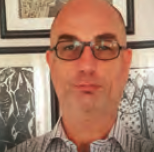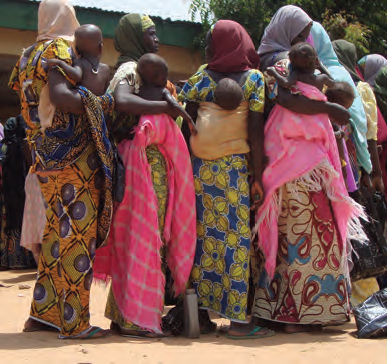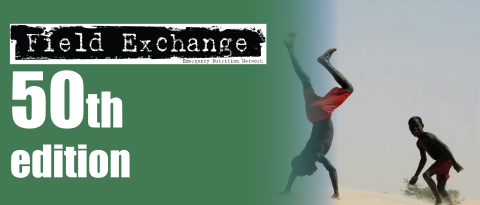Delivering treatment of SAM at scale: lessons learned and forward looking for the Nigeria CMAM programme
Delivering treatment of SAM at scale: lessons learned and forward looking for the Nigeria CMAM programme
By Amy Mayberry and Claire Harbron (CIFF), Arjan De Wagt (UNICEF) and Dr. Chris Osa Isokpunwu (FMOH)
 Amy Mayberry is on the Children’s Investment Fund Foundation’s (CIFF) Evidence, Measurement and Evaluation Team, providing technical expertise on the generation and use of data and evidence across CIFF’s nutrition portfolio.
Amy Mayberry is on the Children’s Investment Fund Foundation’s (CIFF) Evidence, Measurement and Evaluation Team, providing technical expertise on the generation and use of data and evidence across CIFF’s nutrition portfolio.
 Claire Harbron is a Manager in the Nutrition Team at the CIFF. She oversees CIFF’s programme portfolio focused on treatment of severe acute malnutrition.
Claire Harbron is a Manager in the Nutrition Team at the CIFF. She oversees CIFF’s programme portfolio focused on treatment of severe acute malnutrition.
 Arjan de Wagt is Chief of Nutrition at UNICEF Nigeria. During the last 20 years, he has worked for UNICEF (15 years), NGOs and the Zambian and Netherlands Governments in supporting the development and management of nutrition and HIV programming.
Arjan de Wagt is Chief of Nutrition at UNICEF Nigeria. During the last 20 years, he has worked for UNICEF (15 years), NGOs and the Zambian and Netherlands Governments in supporting the development and management of nutrition and HIV programming.
 Dr. Chris Osa Isokpunwu is the Head of Nutrition in the Federal Ministry of Health and the Scaling Up Nutrition (SUN) focal point to Nigeria.
Dr. Chris Osa Isokpunwu is the Head of Nutrition in the Federal Ministry of Health and the Scaling Up Nutrition (SUN) focal point to Nigeria.
The authors acknowledge the input of the following reviewers in producing this article: Augustin Flory, Executive Director at CIFF; Georgina Fekete, Director of Nutrition at CIFF; Christine Kaligirwa, Nutrition Specialist at UNICEF Nigeria; and Assaye Bulti at UNICEF Nigeria.
The authors recognise and thank all partners that have supported the work highlighted in this article, including the Nigeria Federal Ministry of Health and UNICEF for technical support for programme implementation. Additional recognition goes to ACF, Valid International, Save the Children, Results for Development (R4D) and their Nigerian partners Centre for Communication Programmes Nigeria (CCPN), Binomial Optimus Limited (BOL), and Health Systems Consult Ltd (HSCL). Financial support for the programme was provided by the Children’s Investment Fund Foundation (CIFF), DFID, ECHO, EU, USAID, Bill and Melinda Gates Foundation, CERF and JICA over the years. Most importantly, the authors would like to recognise the Local Government Authority (LGA) and State governments in Northern Nigeria and the people delivering these vital services.
The story of Community Management of Acute Malnutrition (CMAM) in Nigeria is one of success and learning; documented in the three following articles by UNICEF/ACF/Mark Myatt; ACF; and Results for Development (R4D). What began in 2009 as a small emergency response in 30 outpatient treatment (OTP) sites, has grown into one of the largest non-emergency CMAM programmes globally. With technical support from UNICEF and funding from the Children’s Investment Fund Foundation (CIFF), ECHO, EU, USAID, JICA, the Bill & Melinda Gates Foundation, CERF and DFID, there are 642 government-run CMAM sites delivering life-saving treatment across 11 states1 in Northern Nigeria today. From 2009 to May 2015, 1,085,498 children have been admitted for treatment – resulting in an estimated 831,686 children cured2 and 207,805 lives saved.
Demonstrating delivery at scale
Despite fluctuating instability in the country, the programme continues to demonstrate that high-quality CMAM services can be successfully delivered at large scale through a government health system. The programme has grown exponentially over the last five years, with more than 320,000 children admitted for treatment in 2014 alone. Overall performance has significantly improved and the majority of states (nine out of 11) now consistently meet SPHERE treatment standards. The 11 states achieved an average 84.5% cure rate as of March 20153. To support further programmatic improvement, a series of SLEAC4 and SQUEAC5 coverage surveys found an average coverage of 36.6% across the 11 states. The leading causes of reduced access to treatment and default rates were lack of awareness of malnutrition and the CMAM programme. This was true across all 11 states. This information is critical for understanding how to improve the programme and ensure high-quality services are available and reaching children in need.
Delivering a cost-effective service
The data from Nigeria confirms that the delivery of CMAM services is a highly cost-effective and affordable treatment. A comprehensive costing analysis shared in the article by R4D6 found an average cost of $219 per child cured, of which $160 are financial costs attributable to the government and UNICEF and $59 are economic costs to beneficiaries and community volunteers. Taking the government and UNICEF costs of $160 per child cured, this translates into $1,117 per life saved and $30 per DALY gained7. This is considered highly cost-effective based on WHO-CHOICE cost-effectiveness thresholds. The Ready to Use Therapeutic Food (RUTF) product is the single largest cost, at roughly $76 per child cured8 (close to 50% of government and UNICEF costs). Efforts are underway to begin producing RUTF locally in Nigeria but it will take time before production can meet demand and it is not clear if this would lower costs significantly in the short-term. CIFF is currently funding Washington University in St. Louis to develop a tool and alternative formulations for RUTF using local ingredients with the aim to reduce cost. Further cost-efficiencies can be achieved at scale as the programme performance continues to improve and existing infrastructure is used to reach more children. In the end, funding for the product is likely to remain the main limiting factor for treating children in Nigeria; the health system is available and able to deliver treatment to many more children but without supplies, this cannot be done.
More children are in need of treatment
Rates of malnutrition remain high in Nigeria and this is an issue that cannot be ignored. In 2015, there will be an estimated 1.8 million9 children with severe acute malnutrition (SAM) in need of treatment. Despite the impressive scale-up seen in recent years, two out of every three children still do not receive the treatment they need in the 11 states where the programme currently operates. As we look forward to the future of CMAM in Nigeria, it is clear that availability of treatment must continue to increase.
This requires increased investment
Based on the above analyses, scaling up the programme will cost up to $160 per child cured. For an average OTP site, with over 500 admissions and 360 children cured per year10, estimated annual costs are $58,157. With an average of five sites per LGA, this translates into a total annual cost per LGA of $290,783 to admit over 2,500 children and cure over 1,800 children. While these costs are not insignificant, they are affordable and scale-up to reach more children with effective, life-saving treatment is essential for a country like Nigeria where the burden is high. Funding support to date has primarily come from international donors but domestic budget allocation of this affordable service is essential for sustainability of the programme to ensure continued treatment of children with SAM. The current domestic budget for nutrition as a percentage of overall government expenditure is low, though exact data are not currently available. In recent years, a number of state governments in Nigeria have specifically included CMAM services in their budgets, with a total of over $2 million committed in 2014. One of these states included significant funding for RUTF procurement but this needs to increase. CIFF will be incentivising this through a matched-funding approach over the next three years.
 A success story with lessons for Nigeria and beyond
A success story with lessons for Nigeria and beyond
The incredible success of this programme, with hundreds of thousands of children cured each year, offers an unparalleled opportunity to reach some of the most vulnerable mothers and children in Nigeria. The OTP sites of the CMAM programme offer an exciting opportunity to integrate additional preventative nutrition services such as Infant and Young Child Feeding (IYCF) and health services in the community and deliver critical interventions to reduce the overall burden of children with SAM in Nigeria.
This programme is also a lesson – for other countries and for Nigeria itself. The programme shows that it is possible to move from a small emergency operation to a national programme delivered through the existing health system and that high quality treatment can be provided to hundreds of thousands of children in regions with chronically high rates of undernutrition. As a highly cost-effective and life-saving service, CMAM and procurement of RUTF for treatment must be a priority for governments to include in their budgets and as part of their routine health services.
1Adamawa, Bauchi, Borno, Gombe, Jigawa, Kano, Katsina, Kebbi, Sokoto, Yobe, and Zamfara. As of May 2015.
275.2% average cure rate from 2009-2014
3UNICEF routine monitoring data (May 2015)
4Simplified LQAS Evaluation of Access and Coverage; LQAS: Lot Quality Assurance Sampling
5Semi-Quantitative Evaluation of Access and Coverage
6Including cost to beneficiaries as well as government costs and UNICEF costs
7As seen in Mark Myatt’s article, this number is much lower when looking only at the UNICEF costs.
8Of total children admitted, only a proportion will be cured so the cost of RUTF per child cured ($76) is higher than the cost of RUTF per child admitted ($54).
9NNHS 2014d
10This assumes a 72% cure rate found in the sites included in the costing study. This is slightly lower than the current national average of 84.5% cured.


